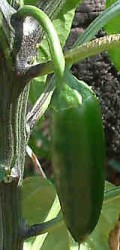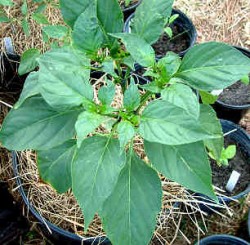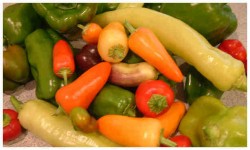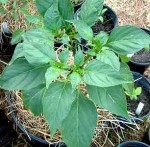Planting Pepper Seeds
Planting pepper seeds is pretty easy. Sure, all you need to do is put the pepper seed in soil, cover it and water it, but there are a few more steps along the way that can up the germination rate of your pepper seeds. Let’s take a quick look.
Seed-Starting Medium
I can’t remember the last time I planted a pepper seed outdoors, directly into the soil. The germination rate is really poor that way, and seed-starting medium (“soil”) is a much better bet.
Go to your local garden center and locate some seed-starting soil. You can use straight sphagnum moss (finely chopped) or sphagnum and vermiculite combined, if you can’t find a ready-made seed-starting medium.
Do not use garden soil directly; there are too many bacteria, spores and whatnot in it; fine for older transplants, not so great for seeds.
Containers for Planting Seeds
You’ll see in the two videos that I’ve used plain paper cups (“Dixie cups”) for my containers. Cheap and easy to find, you can poke holes in the bottom for drainage, and when it comes time for planting, the cup tears away from the soil very easily.
Planting Pepper Seeds Videos
Here are two videos I made on planting pepper seeds. The first one goes over supplies; the second is the actual technique. And after the second video, I’ll list where you can get some of the supplies online, if you can’t find them locally.
Enjoy!
And here’s part 2 of how to plant pepper seeds.
A Bounty of Peppers!
I’ve got a bounty of peppers now, of bell, sweet and hot. The peppers are in full production mode! I took a quick break to walk out to the garden for a harvest.
Once I got the peppers inside and on the counter, I thought they looked really pretty, so I took a photo. And keep in mind, this isn’t all of the peppers — many have already found their way into our tummies. Not to mention there are a ton still on the plants!
In the photo I have Park’s Sweet Banana, Park’s Sweet Pickle, Mini-Belle (in purple and red), Redskin (mostly green), a name-unknown bell and a Cambuci (very hot!). I’m waiting to taste the Cambuci before writing up a post on it, but it’s a really pretty plant and pepper.
A bounty of peppers indeed!
Still Planting Peppers
I’ve got another round of peppers to plant this weekend. Here in Florida, there’s still plenty of time to get in a second crop. So what’s on my agenda? Here’s what I have in mind, but it’s always subject to change.
- Datil
- Aurora
- Purple Jalapeno
- Jaloro (yellow jalapeno)
- Redskin (again — this is one nice bell pepper!)
- Starburst (ornamental pepper)
- Giant Anconcagua (again — absolutely huge sweet peppers!)
I might also go with another round of Pretty Purple Pepper and one of the Thai Hot varieties. I’m also debating adding a larger bell pepper to the list, or maybe Mohawk (the companion to Redskin).
So if you live in a climate where it’s warm (days at least in the 70’s) on up through October or November, come on and plant some more seeds! Or at least see if there are any plants for sale available nearby.
And for the rest of you who already have peppers out in the garden — may you have a bounty of peppers as well!
Jalapenos in the Garden
Jalapenos have to be the most-recognized chile pepper around. You probably see them at the grocery store, and you’ve likely downed your share of them. But what about growing them in the garden?
The Humble Jalapeno
 You may not know this, but there are a multitude of jalapeno varieties. They all have the same basic pepper shape, but would you believe they come in different colors? Not to mention different sizes and Scoville units (“heat” to the uninitiated).
You may not know this, but there are a multitude of jalapeno varieties. They all have the same basic pepper shape, but would you believe they come in different colors? Not to mention different sizes and Scoville units (“heat” to the uninitiated).
Now most of the time the jalapenos you see and/or grow are the green peppers we all know and love. But they come in yellow and purple, too! And all varieties ripen to red (which can be fire-engine or quite deep burgundy).
How Hot — Or Not?
Yes it’s true, these versatile chile peppers come in several degrees of heat. There is the “regular” jalapeno, which is around 4,700 Scoville Units.
There’s also a “lite” variety called Tam Jalapeno that has less heat — somewhere in the vicinity of 2,000 SUs.
And for those who love these peppers but for whatever reason can’t take the heat — there is at least one variety that’s barely at 500 SUs.
To the best of my knowledge, there isn’t a super-hot jalapeno, but if you live in a warm climate, your peppers will get hotter as your weather warms up. In addition, if you let the peppers ripen to red, they are hotter yet!
Jalapenos — Does Size Matter?
You can look at this two ways — size of the pepper itself, or size of the plant.
There’s a variety called Mucho Nacho whose peppers are roughly twice the size of the standard jalapeno — great for anyone who can’t get enough of a good thing!
As far as the plants go — well, be prepared for the possibility of a large plant. Like 4 feet tall and just about as wide (yes, I’ve had them like that). That’s when they are planted in rich, well-drained soil and have plenty of warmth and at least 8 hours a day of direct sunlight.
If your soil, warmth or sunshine isn’t up to snuff, the plants will very likely be smaller; how much smaller depends on the conditions.  But 2 feet tall is a good guesstimate.
 You can also grow these chile peppers in containers (which is what I am personally doing now). A 5-gallon pot will give you plenty of peppers to pick.
You can also grow these chile peppers in containers (which is what I am personally doing now). A 5-gallon pot will give you plenty of peppers to pick.
Just make sure to keep it well-watered and fertilize it more often than you would if it were in the ground. (I like to fertilize weekly, with 1/3 to 1/2 strength liquid fertilizer — fish emulsion is my favorite.)
The plant in the picture is roughly 18 inches tall at the moment, and it’s come through some chilly weather the last month or so. But now that the weather is warming up, I expect it to grow at least another 12 inches by the time everything is said and done. For more information, check out my post on growing chile peppers in containers.
No peppers are ready for picking, but I’ve got plenty of blooms to tantalize me, knowing that most (if not all) will become a hot jalapeno.
While I don’t know for certain, I’m pretty sure this is the variety called Jalapeno M. It’s a nice open-pollinated variety that does well in most climates. If you need some tips, check out the growing chile peppers post.
Jalapeno peppers in the garden are easy to grow and quite forgiving. Give your plant(s) some care and you may end up with more peppers than you know what to do with!


